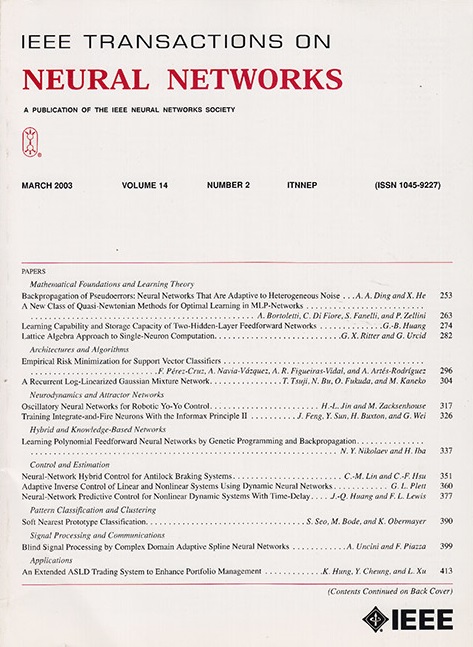用神经网络和信息瓶颈解释良恶性肺结节的分类。
IF 10.2
1区 计算机科学
Q1 COMPUTER SCIENCE, ARTIFICIAL INTELLIGENCE
IEEE transactions on neural networks and learning systems
Pub Date : 2023-10-16
DOI:10.1109/TNNLS.2023.3303395
引用次数: 0
摘要
计算机断层扫描(CT)是临床上鉴别诊断癌症良性肺结节的主要技术。肺结节的早期分类对于减缓退行性变过程和降低死亡率至关重要。神经网络辅助的交互模式被认为是在大量人群中进行早期肺癌癌症筛查的有效手段。然而,高分辨率CT图像中肺结节的一些固有特征,例如,不同的形状和在肺野上的稀疏分布,导致了不准确的结果。另一方面,由于缺乏透明度,大多数现有的神经网络方法都不令人满意。为了克服这些障碍,提出了一个统一的框架,包括分类和特征可视化阶段,以学习不同的特征并提供可视化结果。具体而言,在分类阶段,采用双边方案来同步提取和聚合全局局部特征,其中构建全局分支来感知深层特征,构建局部分支来关注细化的细节。此外,还构建了编码器来生成一些特征,构建了解码器来模拟决策行为,然后从信息瓶颈的角度来优化目标。在两个公开可用的数据集上进行了广泛的实验来评估我们的框架,即1)肺部图像数据库联盟和图像数据库资源倡议(LIDC-IDRI)和2)肺部和结肠组织病理学图像数据集(LC25000)。例如,我们的框架实现了92.98%的准确率,并在LIDC上提供了额外的可视化。实验结果表明,我们的框架能够获得出色的性能,并且能够有效地提高可解释性。它还表明,这个统一的框架是一个有用的工具,并进一步具有可扩展性,可引入临床研究。本文章由计算机程序翻译,如有差异,请以英文原文为准。
Explainable Classification of Benign-Malignant Pulmonary Nodules With Neural Networks and Information Bottleneck
Computerized tomography (CT) is a clinically primary technique to differentiate benign-malignant pulmonary nodules for lung cancer diagnosis. Early classification of pulmonary nodules is essential to slow down the degenerative process and reduce mortality. The interactive paradigm assisted by neural networks is considered to be an effective means for early lung cancer screening in large populations. However, some inherent characteristics of pulmonary nodules in high-resolution CT images, e.g., diverse shapes and sparse distribution over the lung fields, have been inducing inaccurate results. On the other hand, most existing methods with neural networks are dissatisfactory from a lack of transparency. In order to overcome these obstacles, a united framework is proposed, including the classification and feature visualization stages, to learn distinctive features and provide visual results. Specifically, a bilateral scheme is employed to synchronously extract and aggregate global-local features in the classification stage, where the global branch is constructed to perceive deep-level features and the local branch is built to focus on the refined details. Furthermore, an encoder is built to generate some features, and a decoder is constructed to simulate decision behavior, followed by the information bottleneck viewpoint to optimize the objective. Extensive experiments are performed to evaluate our framework on two publicly available datasets, namely, 1) the Lung Image Database Consortium and Image Database Resource Initiative (LIDC-IDRI) and 2) the Lung and Colon Histopathological Image Dataset (LC25000). For instance, our framework achieves 92.98% accuracy and presents additional visualizations on the LIDC. The experiment results show that our framework can obtain outstanding performance and is effective to facilitate explainability. It also demonstrates that this united framework is a serviceable tool and further has the scalability to be introduced into clinical research.
求助全文
通过发布文献求助,成功后即可免费获取论文全文。
去求助
来源期刊

IEEE transactions on neural networks and learning systems
COMPUTER SCIENCE, ARTIFICIAL INTELLIGENCE-COMPUTER SCIENCE, HARDWARE & ARCHITECTURE
CiteScore
23.80
自引率
9.60%
发文量
2102
审稿时长
3-8 weeks
期刊介绍:
The focus of IEEE Transactions on Neural Networks and Learning Systems is to present scholarly articles discussing the theory, design, and applications of neural networks as well as other learning systems. The journal primarily highlights technical and scientific research in this domain.
 求助内容:
求助内容: 应助结果提醒方式:
应助结果提醒方式:


